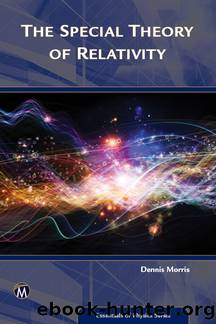The Special Theory of Relativity: An Introduction by Dennis Morris

Author:Dennis Morris [Dennis Morris]
Language: eng
Format: epub
ISBN: 9781942270720
Publisher: Mercury Learning and Information
Published: 2016-09-15T00:00:00+00:00
Note that cosh(âÏ) = cosh(Ï).
The time dilation formula is normally written as:
This is a little confusing because it is the time interval that has dilated, and the formula ought properly to be written with {Ît0, Îtâ²}. Again, we have introduced the c2 factor to adjust the units to those most often used:
This formula says that, if the stationary observer ages by one second, the stationary observer will see the moving observer age by less than one second.
The moving spaceship is moving through space and time; the stationary observer is moving through only time. However, the rate at which they move through space-time (the space-time length of the vector â the distance from the origin to the hyperbola) is the same for both objects; it is one. The only difference between them is a rotation, and so they have to be the same distance from the origin. Because an increase in the space-co-ordinate, z, requires an increase in the time co-ordinate, t, to keep the space-time length of the vector equal to unity (one), as the moving object moves through space, it must move through more time than the stationary observer. The âmore timeâ is the time dilation. There is more time between two events, and so the processes of the universe seem to go slowly on a moving spaceship. Hyperbolic rotation, which is moving the tip of the vector along the hyperbola, increases both the time co-ordinate and the space co-ordinate. This contrasts with Euclidean rotation in which rotation increases one co-ordinate and decreases the other. We repeat this.
Hyperbolic rotation is such that, as the amount of space travelled through increases, so the amount of time travelled through increases. It must do this to keep the (space-time) length of the vector equal to unity. This is because of the minus sign in the distance function.
The (hyperbolic) rotation has taken a vector in space-time that was wholly time (zero space) and changed it to a vector that is part time and part space. Starting with a vector, whose tip was on the hyperbola, and that was lying along the time axis with only a horizontal component, the rotation has rotated this horizontal vector into a vector, whose tip is still on the hyperbola, but that now has both horizontal and vertical components. The vector is the same length (that is space-time length) after rotation as before rotation because the length of a vector is invariant under rotation â constancy of length is, after all, exactly what rotation is about. Hyperbolic rotation is the vectorâs tip moving along the hyperbola.
Therefore, it ought not to surprise us that the time component is different in the rotated vector than in the non-rotated vector. The surprise we feel comes from the fact that, as one rotates in space-time, both co-ordinates increase whereas we are accustomed, in Euclidean space, to one co-ordinate decreasing as the other increases during rotation. Itâs all down to that minus sign in the space-time distance function.
Another way, being careful of the
Download
This site does not store any files on its server. We only index and link to content provided by other sites. Please contact the content providers to delete copyright contents if any and email us, we'll remove relevant links or contents immediately.
The Complete Stick Figure Physics Tutorials by Allen Sarah(7307)
Secrets of Antigravity Propulsion: Tesla, UFOs, and Classified Aerospace Technology by Ph.D. Paul A. Laviolette(5309)
Thing Explainer by Randall Munroe(3877)
The River of Consciousness by Oliver Sacks(3541)
The Order of Time by Carlo Rovelli(3145)
How To by Randall Munroe(3035)
A Brief History of Time by Stephen Hawking(2962)
I Live in the Future & Here's How It Works by Nick Bilton(2935)
The Great Unknown by Marcus du Sautoy(2648)
What If?: Serious Scientific Answers to Absurd Hypothetical Questions by Randall Munroe(2637)
Midnight in Chernobyl by Adam Higginbotham(2483)
Blockchain: Ultimate Step By Step Guide To Understanding Blockchain Technology, Bitcoin Creation, and the future of Money (Novice to Expert) by Keizer Söze(2449)
Networks: An Introduction by Newman Mark(2360)
The Meaning of it All by Richard Feynman(2300)
Easy Electronics by Charles Platt(2282)
The Tao of Physics by Fritjof Capra(2231)
Midnight in Chernobyl: The Untold Story of the World's Greatest Nuclear Disaster by Adam Higginbotham(2177)
When by Daniel H Pink(2083)
Introducing Relativity by Bruce Bassett(2080)
